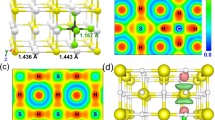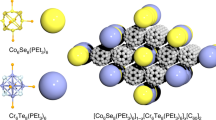Abstract
Under appropriate non-equilibrium growth conditions, carbon atoms form relatively stable hollow clusters of well-defined mass number1, collectively known as fullerenes. The mass production, purification and condensation of such clusters into a molecular solid is generally essential to full experimental characterization: the initial discovery2 of C60, for example, had to await a bulk synthesis method3 six years later before detailed characterization of the molecule was possible. Gas-phase experiments1,4,5 have indicated the existence of a wide range of fullerene clusters, but beyond C60 only a few pure fullerene solids have been obtained6, most notably C70. Low-mass fullerenes are of particular interest because their high curvature and increased strain energy owing to adjacent pentagonal rings could lead to solids with unusual intermolecular bonding and electronic properties. Here we report the synthesis of the solid form of C36 by the arc-discharge method3. We have developed purification methods that separate C36 from amorphous carbon and other fullerenes, to yield saturated solutions, thin films and polycrystalline powders of the pure solid form. Solid-state NMR measurements suggest that the molecule has D6h symmetry, and electron-diffraction patterns are consistent with a tightly bound molecular solid with an intermolecular spacing of 6.68 Å. We observe large increases in the electrical conductivity of the solid on doping with alkali metals.
This is a preview of subscription content, access via your institution
Access options
Subscribe to this journal
Receive 51 print issues and online access
$199.00 per year
only $3.90 per issue
Buy this article
- Purchase on Springer Link
- Instant access to full article PDF
Prices may be subject to local taxes which are calculated during checkout




Similar content being viewed by others
References
Billups, W. E. & Ciufolini, M. A. (eds) Buckminsterfullerenes(VCH, New York, 1993).
Kroto, H. W., Heath, J. R., O'Brien, S. C., Curl, R. F. & Smalley, R. E. C60: buckminsterfullerene. Nature 318, 162–163 (1985).
Kratschmer, W., Lamb, L. D., Fostiropoulos, K. & Huffman, D. R. Solid C60: a new form of carbon. Nature 347, 354–358 (1990).
Rohlfing, C. & Kaldor, J. Production and characterization of supersonic carbon cluster beams. Chem. Phys. 81, 3322–3330 (1984).
O'Brien, S. C., Heath, J. R., Curl, R. F. & Smalley, R. E. Photophysics of buckminsterfullerene and other carbon cluster ions. J. Chem. Phys. 88, 220–230 (1988).
Diederich, F. & Whetten, R. L. Beyond C60: the higher fullerenes. Acc. Chem. Res. 25, 119–126 (1992).
Côté, M., Grossman, J. C., Louie, S. G. & Cohen, M. L. Electronic and structural properties of molecular C36. Bull. Am. Phys. Soc. 42, 270 (1997).
Scott, L. T., Bratcher, M. S. & Hagen, S. Synthesis and characterization of a C36subunit. J. Am. Chem. Soc. 118, 8743–8744 (1996).
Fowler, P. W. & Manolopoulos, D. E. An Atlas of Fullerenes(Clarendon, Oxford, 1995).
Grossman, J. C., Côté, M., Louie, S. G. & Cohen, M. L. Prediction of superconductivity in solid C36. Bull. Am. Phys. Soc. 42, 1576 (1997).
Grossman, J. C., Côté, M., Louie, S. G. & Cohen, M. L. Electronic and structural properties of molecular C36. Chem. Phys. Lett. 284, 344–349 (1998).
Hebard, A. F. et al. Superconductivity at 18 K in potassium doped C60. Nature 350, 600–601 (1991).
Acknowledgements
The study of C36 arose out of a joint experimental/theoretical collaboration with M.L. Cohen, M. Côté, J. C. Grossman and S. G. Lluie, all of whom we thank for discussions and interactions. We also thank J. Burward-Hoy for contributing to the initial stages of this work, T. Wagberg and M. C. Martin for providing the infrared spectrum, A. Pines for discussions and use of his NMR spectrometer, and J. O'Lear for performing the mass spectroscopy runs on the Micromass, Inc. equipment. This work was supported in part by the US Department of Energy, the US Office of Naval Research, and the US NSF.
Author information
Authors and Affiliations
Corresponding author
Rights and permissions
About this article
Cite this article
Piskoti, C., Yarger, J. & Zettl, A. C36, a new carbon solid. Nature 393, 771–774 (1998). https://doi.org/10.1038/31668
Received:
Accepted:
Issue Date:
DOI: https://doi.org/10.1038/31668
This article is cited by
-
Adsorption behavior of metformin drug on the C60 and C48 nanoclusters: a comparative DFT study
Monatshefte für Chemie - Chemical Monthly (2020)
-
Li-Decorated Fullerenes: A DFT Study
Journal of Cluster Science (2019)
-
The Energy Spectrum and the Optical Absorption Spectrum of С36 Fullerene Within the Hubbard Model
Russian Physics Journal (2019)
-
The Magnetic Properties of the Spin-1 Ising Fullerene Cage with a Core-Shell Structure
Journal of Superconductivity and Novel Magnetism (2019)
-
A new superhard carbon allotrope: tetragonal C64
Journal of Materials Science (2017)
Comments
By submitting a comment you agree to abide by our Terms and Community Guidelines. If you find something abusive or that does not comply with our terms or guidelines please flag it as inappropriate.



